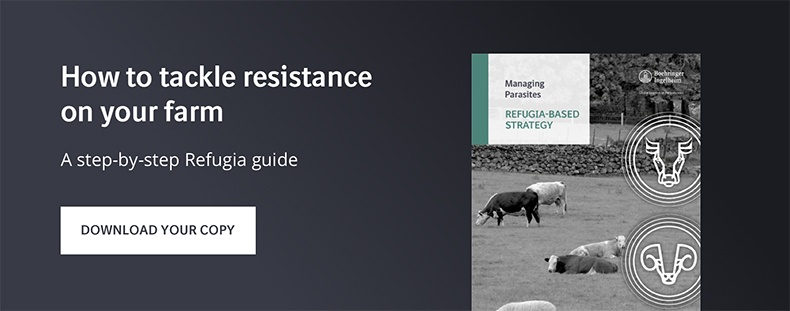Anthelmintic resistance in sheep flocks
For nearly 40 years anthelmintics (wormers) have been very effective at controlling specific parasites in sheep, but over the past decade there have been increasing reports of anthelmintic resistance in sheep flocks around the world, including on British and Irish farms, necessitating a review of the way we approach worm control.
Resistance is genetic, meaning worms which possess genes that enable them to survive an anthelmintic treatment will reproduce. With ongoing selection for resistance, those genes will become more prevalent in each generation.
Worm populations are said to be resistant when 5 per cent of worms survive anthelmintic treatment
What about poor performance
However, the poor performance and ill-thrift associated with lack of wormer effectiveness may not become clinically apparent until 50 per cent or more of the worm population are resistant to the active ingredients being used.
Implementing practices to reduce selection for resistance before it is too late is critical.
According to Sustainable Control Of Parasites in Sheep (SCOPS), the number of cases of anthelmintic resistance in the UK has risen sharply in recent years (1).
Over-reliance on anthelmintics
Sioned Timothy, ruminant technical manager at Boehringer Ingelheim Animal Health, says: “The over-reliance on anthelmintics and limited use of other strategies to reduce parasite burdens in flocks has led to this situation where reports of resistance are increasing.
“Repeated use of the same class of wormers, and the difficulty in identifying low-level anthelmintic resistance, means some flocks have populations of worms which are nearly entirely resistant to one of more groups of commonly used wormers.
This should be of great concern to all sheep farmers.”
Impact of parasites on lamb production
Gastrointestinal (GI) or stomach parasites cause production loss.
The impact of parasites on lamb production is estimated to cost the British sheep industry more than £84 million (2).
These losses come from lamb deaths, delayed finishing times and increased costs from labour and medicines.
The most common GI worm species which cause production loss include the ‘brown stomach worm’ Teladorsagia (Ostertagia) circumcincta, ‘black scour worms’ Trichostrongylus colubriformis and Trichostrongylus vitrinus, ‘barber’s pole’ worm Haemonchus contortus and ‘stomach hair’ worm Nematodirus battus.
The seasonality and clinical signs of a worm challenge in lambs varies slightly by worm species, but all cause reduced appetite and reduced absorption of nutrients.
A high worm burden can also significantly reduce daily liveweight gain in lambs without animals showing any clinical signs, resulting in costly production losses and difficulty finishing lambs.
When outbreaks of clinical disease occur they can be acute, and sudden in onset, with large numbers of lambs showing symptoms and often some deaths occurring.
Ms Timothy says: “If we continue to see the rate of sheep wormer resistance grow it will be increasingly difficult, if not impossible, to control parasitic disease from GI worms.
“The effect will be widespread, from welfare issues in infected animals, to severe production losses.
We could get to the point where it is uneconomical to produce sheep on some farms, so it is vital all livestock producers take action now.
How to preserve wormer effectiveness
Follow SCOPS guidance on sustainable worm control.
This includes reducing reliance on wormers, using best practice when you administer anthelmintics, taking other measures to reduce parasite challenge to susceptible animals and testing if you suspect resistance.
Ms Timothy provides eight tips for responsible wormer use:
- 1. Use grazing management and good nutrition strategies to reduce your reliance on wormers.
- 2. Use diagnostic tests, such as faecal egg counts, and monitor lamb performance by regularly weighing. This allows you to treat only those animals which are not meeting growth targets.
- 3. Minimise treatments in adult sheep if they are fit and healthy, as they will have acquired immunity to worm species.
- 4. Use anthelmintics with the narrowest spectrum of activity to treat the target worm species. Diagnostic testing can help identify which species are likely to need to be controlled.
- 5. Administer products correctly and at the right dose, in accordance with the product packaging. Group and weigh all sheep, dosing to the heaviest animal in each group.
- 6. Preserve non-resistant (susceptible) worms on the pasture by leaving some animals untreated, or turning treated sheep back onto contaminated pasture for a few days. Do not ‘dose and move’.
- 7. Test for resistance if you are concerned about the effectiveness of your treatments.
- 8. Quarantine incoming sheep and treat with a group 4-AD or group 5-SI, and a group 3-ML, to ensure removal of all worms before mixing incoming sheep with the home flock or turning onto clean pasture.
Anthelmintic groups
Anthelmintics are grouped into five colour-coded classes.
All of these groups can be used to treat gastrointestinal worms.
However, anthelmintic resistance is increasingly being reported across some of the groups.
- Group 1: BZ white benzimidazoles
- Group 2: LV yellow levamisole
- Group 3: ML clear macrocyclic lactones
- Group 4: AD orange amino-acetonitrile derivatives
- Group 5: SI purple spiroindoles
In Wales, a recent study reported that evidence of resistance to the group 1-BZ anthelmintics had been found on 94 per cent of farms, while resistance to group 2-LV was found in 68 per cent and 51 per cent to the group 3-ML treatments (3).
While there is less evidence of resistance to newer groups, 4-AD and 5-SI, the continued responsible use of these products may help prolong their effectiveness and that of other anthelmintic groups.
For more on Responsible Control Practices Click here.
